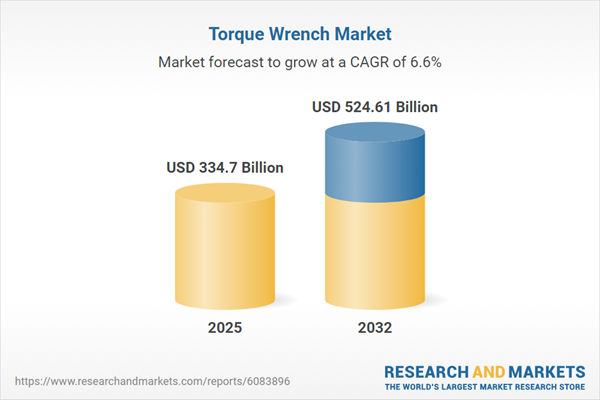Speak directly to the analyst to clarify any post sales queries you may have.
The torque wrench market is experiencing sustained growth, driven by rising precision requirements in key sectors and ongoing advancements in digitalization. Industry leaders seeking to enhance reliability, compliance, and operational efficiency will find timely, data-backed insights into evolving demand, technology integration, and competitive strategies.
Market Snapshot: Robust Growth Trajectory for Precision Torque Control Tools
The torque wrench market expanded from USD 313.61 billion in 2024 to USD 334.70 billion in 2025 and is projected to continue growing at a CAGR of 6.64%, ultimately reaching USD 524.61 billion by 2032. The adoption of torque control tools is supported by accelerating technical standards across aerospace, automotive, industrial, and construction sectors, with digital technologies increasingly embedded to satisfy traceability and compliance requirements. This momentum highlights the sector’s importance for organizations prioritizing equipment reliability and product integrity.
Scope & Segmentation: Analyzing the Market Landscape
- Type: Market assessment includes beam, click, dial, and digital torque wrenches, each valued for unique performance characteristics in precision applications.
- Drive Size: Segmentation by 1/2 inch, 1/4 inch, 3/4 inch, and 3/8 inch drive sizes reflects diverse use cases, ranging from delicate assemblies to heavy equipment maintenance.
- Application: Coverage spans aerospace, automotive, construction, and industrial environments, supporting a variety of quality assurance and safety mandates.
- End User: Aftermarket service providers and original equipment manufacturers, each with specific calibration, flexibility, and supply partnership needs.
- Distribution Channel: Analysis of offline purchasing for high-value equipment and online channels supporting fast procurement of consumables and spare parts.
- Region: Insights provided for the Americas (North America, Latin America), Europe, Middle East & Africa, and Asia-Pacific, with in-depth attention to regional manufacturing clusters, regulations, and infrastructure investments.
- Technology Trends: The report reviews the impact of sensor integration, real-time data analytics, wireless communication, and interoperability as market drivers and differentiators.
- Company Profiles: Detailed analysis of key players, including Snap-on Incorporated, Stanley Black & Decker, Apex Tool Group, Robert Bosch GmbH, and others.
Key Takeaways: Strategic Insights for Senior Decision Makers
- Precision torque tools have shifted from basic mechanical devices to central elements in predictive maintenance, traceability, and compliance frameworks across industries.
- Digital transformation is driving adoption of advanced torque control solutions, supporting data logging, traceability, and integration with ERP and maintenance systems.
- New tariff structures have altered sourcing strategy and reinforced investments in domestic production capacity and supplier diversification to mitigate supply chain volatility.
- Demand segmentation by tool type, drive size, and application demonstrates the importance of customizable solutions tailored to varying operational constraints and technical standards.
- Companies are securing competitive advantage through innovation alliances, digital service platforms, and the provision of robust aftermarket calibration networks.
- Regional differences in regulatory rigor, industrial base, and infrastructure have significant influence on torque tool preferences and supplier strategies.
Tariff Impact: Adapting Supplier and Sourcing Strategies
Recent tariffs on imported torque control instruments have prompted organizations to diversify supplier networks, reassess procurement strategies, and invest in local manufacturing. These shifts have spurred broader collaboration between tool manufacturers and calibration service providers to contain rising costs and enhance service value. Optimization of maintenance cycles and expanded adoption of bundled service contracts are becoming standard responses to inflationary pressures and trade adjustments.
Methodology & Data Sources
Research for this report combined thorough secondary analysis of industry publications, standards, and white papers with primary interviews of engineering managers, calibration specialists, and procurement executives. Quantitative surveys and data aggregation from service centers were cross-validated using triangulation methods and advanced statistical analysis, with double-blind data checks employed to maintain robust quality standards and minimize bias.
Why This Report Matters
- Enables senior leaders to benchmark technology integration, compliance readiness, and procurement strategies across global and regional peers.
- Supports investment decisions with segmented insights into supply chain adaptation, digital transformation, and competitive positioning.
- Equips teams to identify growth markets, optimize supplier relationships, and mitigate risk in a rapidly evolving regulatory environment.
Conclusion
The torque wrench market is evolving as a strategic asset across critical sectors, with technology advancements and adaptive sourcing shaping future outcomes. Organizations equipped with market intelligence and actionable insights will better position themselves for sustained growth and operational resilience.
Table of Contents
3. Executive Summary
4. Market Overview
7. Cumulative Impact of Artificial Intelligence 2025
Companies Mentioned
The companies profiled in this Torque Wrench market report include:- Snap-on Incorporated
- Stanley Black & Decker, Inc.
- Apex Tool Group, LLC
- Robert Bosch GmbH
- Tohnichi Mfg. Co., Ltd.
- Norbar Torque Tools Ltd.
- Atlas Copco AB
- Wera Werkzeuge GmbH
- Kyoto Tool Co., Ltd.
- Gedore GmbH & Co. KG
Table Information
| Report Attribute | Details |
|---|---|
| No. of Pages | 192 |
| Published | October 2025 |
| Forecast Period | 2025 - 2032 |
| Estimated Market Value ( USD | $ 334.7 Billion |
| Forecasted Market Value ( USD | $ 524.61 Billion |
| Compound Annual Growth Rate | 6.6% |
| Regions Covered | Global |
| No. of Companies Mentioned | 11 |









